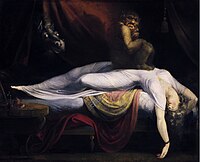
Photo from wikipedia
The less rigid architecture of sleep in patients with narcolepsy type 1 (NT1) compared with healthy subjects may provide new insights into some unresolved issues of dream experience (DE), under… Click to show full abstract
The less rigid architecture of sleep in patients with narcolepsy type 1 (NT1) compared with healthy subjects may provide new insights into some unresolved issues of dream experience (DE), under the assumption that their DE frequencies are comparable. The multiple transition from wakefulness to REM sleep (sleep onset REM period: SOREMP) during the five trials of the Multiple Sleep Latency Test (MSLT) appears of particular interest. In MSLT studies, NT1 patients reported a DE after about 80% of SOREMP naps (as often as after nighttime REM sleep of themselves and healthy subjects), but only after about 30% of NREM naps compared to 60% of daytime and nighttime NREM sleep of healthy subjects. To estimate accurately the “real” DE frequency, we asked participants to report DE (“dream”) after each MSLT nap and, in case of failure, to specify if they were unable to retrieve any content (“white dream”) or DE did not occur (“no-dream”). The proportions of dreams, white dreams, and no dreams and the indicators of structural organization of DEs reported after NREM naps by 17 adult NT1 patients were compared with those reported by 25 subjects with subjective complaints of excessive daytime sleepiness (sc-EDS), who take multiple daytime NREM naps. Findings were consistent with the hypothesis of a failure in recall after awakening rather than in generation during sleep: white dreams were more frequent in NT1 patients than in sc-EDS subjects (42.86 vs 17.64%), while their frequency of dreams plus white dreams were similar (67.86 and 61.78%) and comparable with that of NREM-DEs in healthy subjects. The longer and more complex NREM-DEs of NT1 patients compared with sc-EDS subjects suggest that the difficulty in DE reporting depends on their negative attitude toward recall of contents less vivid and bizarre than those they usually retrieve after daytime SOREMP and nighttime REM sleep. As this attitude may be reversed by some recall training before MSLT, collecting wider amounts of DE reports after NREM naps would cast light on both the across-stage continuity in the functioning of cognitive processes underlying DE and the difference in content and structural organization of SOREM-DEs preceded by N1 or also N2 sleep.
Journal Title: Frontiers in Neuroscience
Year Published: 2020
Link to full text (if available)
Share on Social Media: Sign Up to like & get
recommendations!